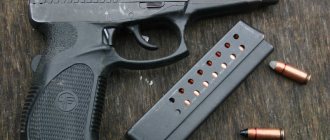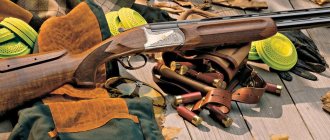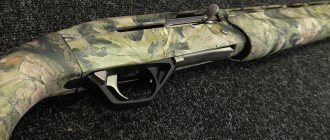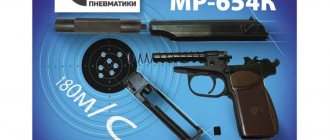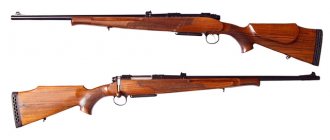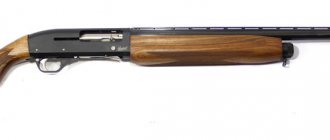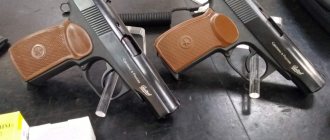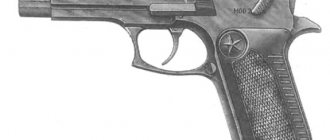PM
or, in full name,
“Makarov Pistol arr.
1951" - a pistol developed by Nikolai Fedorovich Makarov as part of the state competition of 1947-1948. and adopted by the Soviet Army in 1952. In Russian culture it is inextricably linked with the image of a Soviet policeman; in foreign countries it is invariably associated with the Red threat. It is still in service with all law enforcement agencies of Russia, most post-Soviet states and countries of the former socialist camp.
History[edit]
The Great Patriotic Red Army fought with the Tokarev pistol (TT). It also had undeniable advantages (mainly in the area of manufacturability), but it also had plenty of disadvantages: not the highest reliability, large dimensions, powerful, but rather controversial ammunition[1]. In addition, the idea of the tactical role of a pistol has changed: if before the war it was considered a full-fledged means of combat, then, based on the experience of combat operations, it began to be considered a weapon of last chance for commanders and a (highly optional) spare weapon for fighters. Therefore, the tactical and technical requirements were drawn up according to the principle “sad, but practical”: strict restrictions on dimensions and weight, the highest requirements for reliability and reliability, short time for the first shot (a TT with a single-action trigger had certain problems with this).
Especially for the promising pistol, Boris Vladimirovich Semin developed a new ammunition - the 9x18 cartridge. During its development, the experience of German colleagues was taken into account (for the same reasons, they created the 9x18 Ultra cartridge with similar characteristics, but before the war the military department rejected it, and during the course of it it could barely cope with supplying a zoo of German and captured pistols in five main calibers to accept another cartridge), while the geometry of the cartridge was revised to adapt to Soviet production lines (cut-off TT cartridges were used for prototype PM cartridges). The cartridge turned out to be quite successful: it is, of course, inferior to the Luger in terms of penetrating action (quite expected), but in terms of its effect on soft tissue it is comparable to .45ACP (test reports are given in the monograph by V. N. Dvoryaninov “Combat Cartridges of Small Arms”, those who wish can take communion), and most importantly, it allows the use of simple automatics in pistols with a blowback recoil.
The Makarov pistol won a completely deserved victory at the 1947-1948 competition, beating the designs of Rakov, Simonov, Korovin, Sevryugin and many other honored gunsmiths. In 1949, a batch of pistols was produced for military testing, following which it was put into service in 1952. Full production began in 1953.
Baikal Electronics showed a new domestic processor Baikal-M at a closed presentation
held a closed presentation of its second processor Baikal-M, which is implemented on ARM architecture. The first processor, Baikal-T1, was implemented on the MIPS architecture, designed for processors with a reduced instruction set.
According to the developers, Baikal-M is a processor produced using a 28 nm process technology. It is a system-on-chip “based on eight 64-bit ARM Cortex-A57 (ARMv8-A) cores with support for NEON vector extensions and an eight-core Mali-T628 (MP8) graphics processor with hardware accelerated video playback in H. 264/H.265." Processor Specifications:
- TSMC 28HPM Technology
- CPU: 8 cores ARM CortexA57, ARMv8-A, (4 clusters of 2 cores), up to 1.5 GHz
- GPU: 8 Mali-T628 cores, up to 500 MHz L2 cache: 1 MB per cluster
- L3 cache: 8 MB
- Memory controller: 2 × DDR3/DDR4-2400 64 bitDRAM,ECC
- Power consumption less than 30 W
Built-in Interfaces
- 2 × 1 GbEthernet(RGMII)
- 2 × 10 GbEthernet(10GBase-KR/KX4)
- 3 × PCIeGen.3 (8+4+4 lanes)
- 2×SATA 6G
- 4 × USB2.0
- 2 × USB3.0/2.0
- 4K @30fps video decoder
- QLVDS QHD/WQXGA (2560×1440/2560×1600)@60Hz
- HDMI 2.0 UHD (3840×2160)@60Hz
- HD Audio
- I2S
- 2 × SMBus
- 1×SPI
- 1 × eSPI
- 2 × UART
- 32×GPIO
- eMMC/SD/SDIO
- CoreSight(SW/JTAG, MIPI PTI)
Housing characteristics
- Type – FCBGA
- 40 × 40 mm
- 2.8/3.05/3.3 mm – height (min/nom/max)
- 1521 outputs
- 1 mm pitch
- 0.6mm contact diameter
The processor has extensive capabilities, thanks to which it can be used in workstations, all-in-one PCs, laptops, servers and thin clients.
The processor was first shown at the V international forum “Microelectronics 2019”, which was held in Alushta. But this was a closed presentation for government organizations. The official announcement is scheduled for October 22-23, the processor will be shown at the Open Innovations forum.
As for the timing of the processor's release, Baikal-M should have entered the market three years ago. So, at the beginning of 2020, developers talked about the imminent release of three new processors based on ARM architecture, which can be used on different systems. Engineering samples of the processor were supposed to appear before the end of 2020.
However, this did not happen, although she received money from the state budget to implement her plans. The project was called “Development and implementation of a domestic energy-efficient microprocessor for personal computers.” For its implementation, the developers received a subsidy in the amount of 1.1 billion rubles. The total cost of the project is 2.3 billion rubles.
After this, the release of the processor was planned for 2020. “The development of the Baikal-M processor (BE-M1000) was completed in 2018. A batch of microprocessors is currently being produced and will be launched on the market. In the middle of this year, BE-M1000 will be available to development companies for prototyping and production of prototypes of final devices,” Mikhail Makhson, ex-CEO of Baikal Electronics, previously stated.
In May, an article was published on Habré, which stated that the processor developer faces a huge fine for delay. But so far this has not happened, despite the fact that the agreement between the Ministry of Industry and Trade and the developers stated that “deviations within 12 months of the actual values of the performance indicators for the implementation of a complex project based on the results of each half-year of the project are more than 30% from the planned values.” Upon termination of the contract, “the organization is obliged to return the corresponding funds to the federal budget... within 10 working days from the date of receipt of the relevant requirements from the ministry.”
The first processor, BE-T1000, was developed at the end of 2014 and launched into production in 2020. The development was carried out with the support of the Ministry of Industry and Trade with the involvement of funds from the department and the federal target program “Development of electronic component base and radio electronics for 2008-2015,” as well as investments and the “T-platform” (parent structure of Baikal Electronics). At that time, information about the size of the investment was not disclosed.
JSC Baikal Electronics was registered in January 2012. Co-founders are the developer of T-Platform and . The main founder is Rusnano with a share of 62.8%.
Main options[edit]
Combat[edit]
- MP
(sic!) produced in
1949
- pre-production release. The first 30 pieces were manufactured at the Tula Arms Factory (one of them can be seen in the TsMVS exhibition; another is known as a gift to J.V. Stalin from Tula gunsmiths), another 5000 - at the Izhevsk Mechanical Plant No. 622. - PM
produced
1953-54
. — a small feature has been made: the automatic reset of the slide stop when a full magazine is attached has been removed, because the feature could lead to an accidental shot. - PM
produced
after 1954
- the shape of the frame has been changed for greater ease of shooting with winter gloves. It is still produced today with minor changes. In the army it is gradually being replaced by the Yarygin pistol, in the FSO - by foreign-made pistols, in the Ministry of Internal Affairs it will remain the main pistol until the end of time for many, many years. - PMM
- modernized version of 1994.
Designed for firing a reinforced cartridge in the same dimensions as the old one, therefore it is equipped with a massive bolt and Ivshin grooves in the chamber (the principle of operation is similar to the Revelli grooves, but has a different geometry). It is also almost always equipped with a double-row magazine with a capacity of 12 rounds (on paper there is also a version with a standard single-row magazine for 8 rounds - PMM-8, but, apparently, production did not go beyond several prototypes). Attention!
The main defining feature of the PMM is the bolt, and not the two-row magazine.
Calling any macaroid with a wide handle but a regular bolt “PMM” is stupid. Attention-2!
Production of PMM has been discontinued. Yes exactly. Good night, sweet prince! And the ordinary PM is alive and well. Dear MTA, if you are describing a realistic setting with a time period after the second half of the 2000s and your policeman/military gets a brand new PMM instead of the old Makar, don’t write! Think about it! Such a pistol cannot be new, at most it can be left over from the old days.
The PMM can fire the old cartridge: when firing it, the Ivshin grooves do not slow down the rollback; The PM, on the other hand, does not withstand firing with a reinforced cartridge.
- Prototype from 1947. Note the lack of a swivel bracket.
- Pistol 1949 with MP markings (Makarova Pistol)
- PM 1953
- PM produced after 1954 (different frame shape)
- PMM. Pay attention to the shape of the shutter
Official, civil and commercial[edit]
- Izh-71
is a 9×17 caliber service pistol. A security guard might have one. There is an option with a double-stack magazine with a capacity of 10 rounds (according to the Weapons Law, 12 are not allowed). - Izh-70
(
IJ-70
) - export commercial versions. Available in 9×18 and 9×17 calibers, with single or double stack magazines, fixed and adjustable rear sights, standard blued finish or decorative finish. Capitalism, however! - Baikal-442
is an export modification developed specifically for the US market.
It comes standard with a double-stack, fully adjustable magazine, a side magazine release button and a reshaped trigger guard. After the United States introduced restrictions on the import of Izhmekh pistols, they forgot about it for a long time - but recently they remembered and certified it on the Russian market as the “ Baikal-442
” sports pistol (now in Cyrillic). - Izh-79
,
MP-79
,
MP-80
,
PM-T
,
P-M17T
- gas and traumatic pistols, one of the most popular on the Russian civilian weapons market. - MP-654K
is an air pistol produced by the Izhevsk Mechanical Plant. In cinema, he regularly passes for a combat PM from afar.
Partially based on PM design[edit]
- PB
(silent pistol) - a pistol with an integrated silencer designed by A. A. Deryagin. Contrary to popular misconception, the PB differs significantly from the PM in design and in no way can be called a “PM with a silencer.” However, the magazine and most of the trigger parts are unified with Makarov's. - PSS
“Vul” is much more similar to the PM structurally (and much less externally). Silent pistol chambered for a special closed-type cartridge SP-4.
Foreign production[edit]
- Under Soviet license, the PM was produced in the GDR ( Pistole M
), China (
Type 59
), Vietnam (
K59
) and Bulgaria (
Makarov Pistol
(sic!) and the modernized
Arsenal R-M01
).
Non-existent[edit]
- PM with silencer. It has never been produced by anyone (with the exception of artisanal criminal alterations). The prevalence in cinema can be somehow justified by the unavailability of authentic PB and the presence of pneumatic replicas with a false muffler. Common in other forms of art is banal hackwork and problems with weapons.
Smoothbore shotgun Baikal MP-131K / Baikal MP-131K (Russia)
The Baikal MP-131K smoothbore shotgun was developed in 1997 at the Izhevsk Mechanical Plant on the basis of the Izh-81K shotgun, and differed from most analogues in the original selective feeding circuit with cartridges from two magazines. The MP-131K shotgun was produced in a limited series at IMZ and exported, including to the USA. However, due to the low demand for shotguns with selective dual-magazine feeding, their increased complexity and price, its production of the Baikal MP-131K shotgun was very limited, and it was discontinued in the early 2000s.
Smoothbore shotgun Baikal MP-131K
The Baikal MP-131K smoothbore shotgun uses reloading using a movable forend, or the so-called “pump-action” circuit. The barrel bore is locked by a swinging wedge located inside the bolt. Under the barrel of the gun there is a non-removable tubular magazine with a capacity of 5 rounds, loaded through a window in the lower part of the receiver. This same window serves as a receptacle for detachable box magazines, so that replenishment of a tubular magazine is only possible with the box magazine detached.
Smoothbore shotgun Baikal MP-131K. The box magazine is disconnected. On the left is the magazine in the “off” state, on the right - in the “on” state
The original power switching mechanism was built into a detachable box magazine, which consisted of an outer casing adjacent to the gun from below, and a magazine with a spring and feeder located inside the casing, which had the ability to move vertically inside the casing. To switch the supply of cartridges in the Baikal MP-131K shotgun, a lever was used on the right side of the detachable magazine body. When the lever was in a horizontal position, the internal magazine was lowered down and was not used; cartridges were fed from an under-barrel tubular magazine. When the lever was turned up to a vertical position, the internal magazine rose upward so that its upper cartridge was on the line of chambering into the barrel, and the movable front wall blocked the exit of cartridges from the tubular magazine. It is clear that such interchangeable magazines had quite a significant complexity and cost, so this system never waned in popularity, remaining in history as an original and interesting exotic.
In the basic configuration, the Baikal MP-131K / Baikal MP-131K shotgun had a wooden butt with a semi-pistol neck and a wooden movable forend, the barrel length could vary from 56 to 70 cm, the barrels could be equipped with a ventilated sighting rib. The capacity of the under-barrel magazine is 4 rounds (up to 7 rounds with a removable extension installed), the detachable box magazine is 3. The manual safety has the form of a transverse button located behind the trigger.
| Characteristic | Meaning |
| Chuck used | 12 gauge |
| Automation type | manual reload |
| USM type | sa |
| Barrel length, mm | 560 — 710 |
| Weight without cartridges, kg | 3,6 |
| Magazine capacity, cartridges | 3, 4, 7 |
Popular misconceptions[edit]
- “The PM is based on the Walther PP design or is even a clone of it.” The Kalashnikov assault rifle (which is also a clone of the StG.44) sympathetically pats its younger brother on the shoulder. There is definitely a slight external resemblance, but it becomes less and less the further we begin to disassemble the pistols. The trigger has absolutely no similarities, the mounting of the barrel to the frame is implemented in a completely different way, the approach to the design of the bolt stop is different at the conceptual level. The only clearly borrowed solution was the trigger guard - but Nikolai Fedorovich Makarov had nothing to do with its appearance: the pistols he submitted for the competition did not have such an assembly, and their disassembly was carried out by moving down a special part - the contactor. The “Walter” bracket appeared only at the stage of preparation for production at the suggestion of testers. As for using a free shutter, this solution appeared long before Walter and was one of the most common in those years. Moreover, the cartridge was designed specifically for the use of this solution.
- “The PM is a very inaccurate pistol.” A person who does not have shooting practice will really shoot shamelessly with a PM - much more than with almost any other pistol. This is the design feature of this weapon: a short barrel, fast gunpowder and a fairly heavy bullet cause, if not strong, but very sharp recoil. The not-so-comfortable handle (hello to competitive size requirements!) further aggravates the already poor control. However, everything changes with practice. No, the PM, of course, does not turn into a sniper pistol. But the accuracy goes from “none” to hmmm... just normal. Not good enough to compete with Glock or even PYa, but quite good enough to surpass its predecessor, the TT, with a margin.
- “The PM has a weak cartridge.” It all depends on the method of data collection: some measured, others surveyed. Such a statement is usually supported by: a) nothing (option: damage in games); b) comparison of muzzle energy; c) comparison of penetrating ability. And never, never - with full-fledged results of shooting against a biological tissue simulator (measuring not the depth of penetration, but the volume of the affected tissue and a temporary pulsating cavity). Because in terms of lateral action, the Makarov bullet is not inferior to the Luger bullet and is head and shoulders above the bullet of the 9x17 cartridge. Some truth: the penetration action is frankly weak. The PM is truly ineffective against an enemy in the SIBZ. And it’s not required. The criminals that the police are fighting wear body armor a little more often than never, and in the army a pistol is more of a symbol of officer power; in front-line conditions they don’t shoot at a real enemy with it.
, the name of which is PPO (officially: patron of law enforcement agencies, unofficially - the first word is replaced by an obscene one). Developed by order of the Ministry of Internal Affairs with the requirement to improve accuracy and reduce the lethal effect: too often suspects did not live to see trial. With noticeably increased numbers (this cartridge has higher bullet speed and muzzle energy), the combat qualities of the cartridge have noticeably dropped compared to the old P and Pst.
Where it occurs[edit]
General[edit]
- Almost any work about the Soviet/Russian militia/police.
- Most of the works are about the post-war Soviet army.
- Any Russian action movie. And also a detective, crime drama or crime comedy. Be it a movie, series, book or something else.
Literature[edit]
- Books by Boris Gromov are almost everywhere. Not surprising, since the author is a riot policeman.
- Suren Tzormudyan, “There will be no second chance” - one of the cosmonauts bears the surname Makarov. Just think, Makarov and Makarov, are there not enough of them? However, the author has a tradition of naming characters in honor of historical figures he respects, and this is a clear homage to Nikolai Fedorovich. And in “The Heritage of Ancestors” Stechkin also appeared.
- Dogs of War - The PM was armed with a Soviet military expert who killed one of the mercenaries and was shot by Shannon. Shannon uses it to kill Colonel Bobi. Not Shannon. According to canon, a Belgian hit him with a bazooka. He almost sawed Shannon out.
Cinema[edit]
- “Case No. 306” is the pistol of police captain Mozarin. First appearance in cinema.
- "Planet of Storms" is the personal weapon of Professor Ivan Shcherba, commander of the Vega.
- "Makarov" is the center of the plot.
- “Atomic Blonde” - every second character, because the action takes place in East Germany. There are at least a couple of authentic GDR-made Pistole Ms present. There is also a non-existent IRL PM with a silencer.
- "The Beast" (1988) - American anti-Soviet propaganda. The spiteful Russian tank commander Daskal willingly uses his service weapon against his crew.
- “Island” - unexpectedly, as an elite weapon. Chrome plated PM in a solid case marked “Makarov 55”.
- “Sheriff’s Star”[2] - PM is used by both law enforcement officers and killers. In the USA, yes.
- "The Student" is a familiar story from Crime and Punishment, now set in modern times. Instead of an authentic axe, the Student uses a Makarov pistol.
- “24-25 does not return” - Mara wears a service pistol in an operational holster of clearly non-Soviet production and looks very fanservicey at the same time.
- “Moscow Heat” - in one of the scenes, the hero of the Nevsky Uotakuot holds his PM: not only does it sideways, but he also grips the bolt from above. When fired, this threatens at least an open fracture of a finger.
I know how to grip and hold a pistol like the back of my hand!
TV series[edit]
- “17 Moments of Spring” is a misconception so popular that it is worthy of mention here: it is believed that Stirlitz shot Klaus with a PM posing as a Walther PP. In fact, he has FN Mod. 1910, depicting himself: such pistols were not uncommon in the Third Reich.
- Dexter is Isaac Sirko's weapon of choice.
- “The Far Side of the Moon” is quite naturally present in the first season of the 1979 police officers (except for the fact that the pneumatic guns were removed from the PM role). It is not particularly present in the second season - police officers in 2011 are not allowed to carry service weapons. But Dymov has Makarov. Award.
- "Boss Lady" - where you wouldn't expect to see a Makarov pistol is in a Japanese drama. But it is here - as a weapon for terrorists.
Video games[edit]
- STALKER - PM (called PMm) is widespread in the Zone and becomes the first pistol for every protagonist. PB also exists, but it is much less common. “Call of Pripyat” contains a unique “Award PMM”, belonging to Major Degtyarev and differing from the original only by the engraving “For the successful completion of especially dangerous assignments and displaying valor and courage,” as well as slightly reduced wear. Just the thing for an undercover SBU agent, especially if he decides to sell or modernize this gun.
